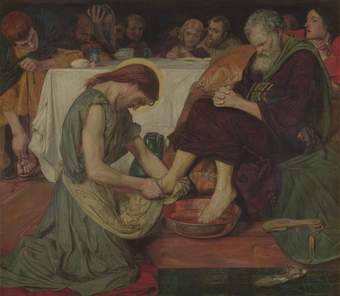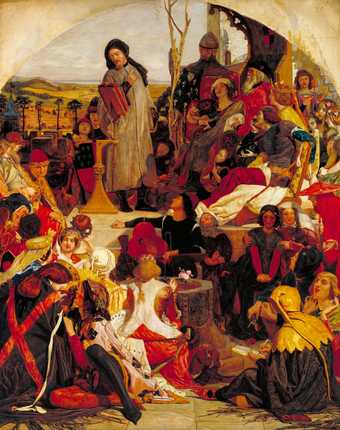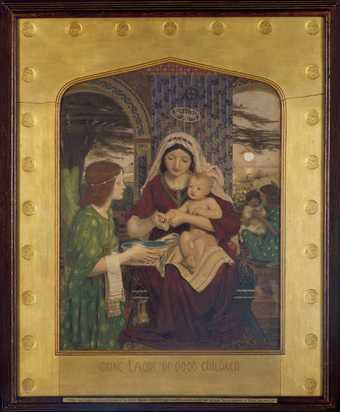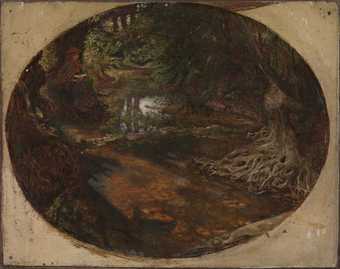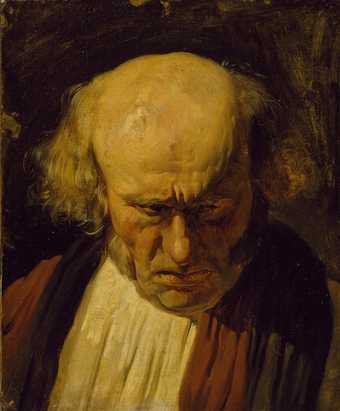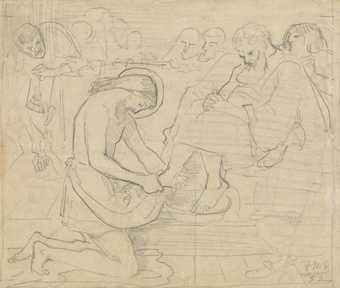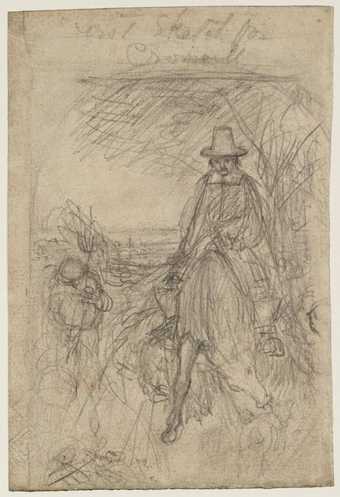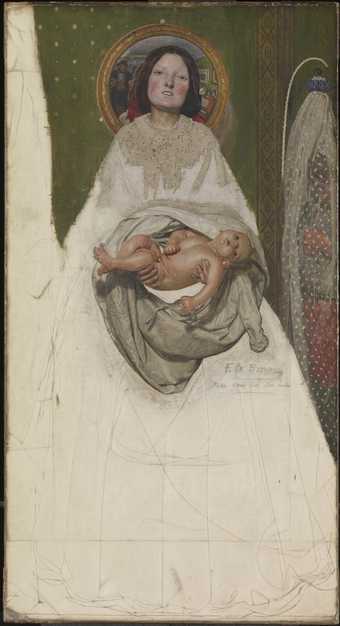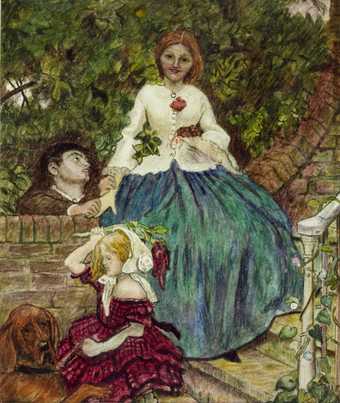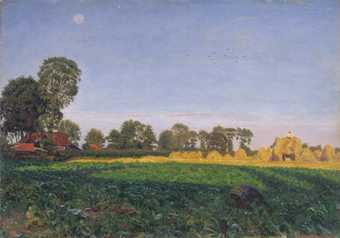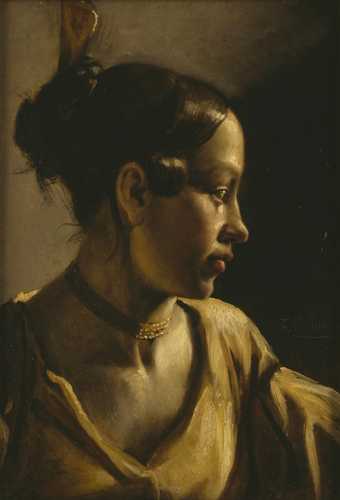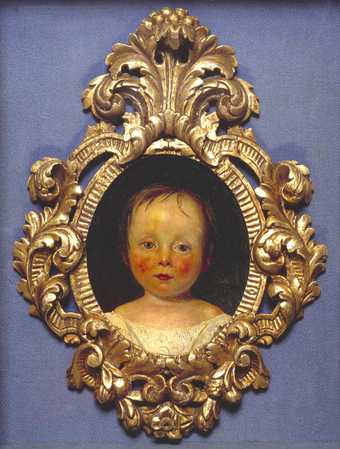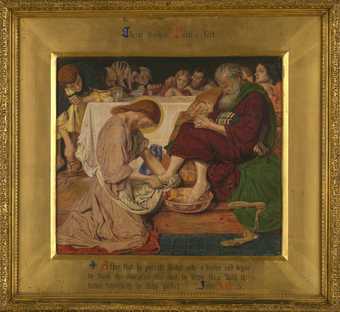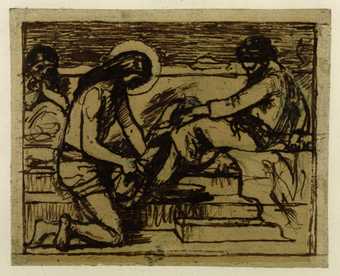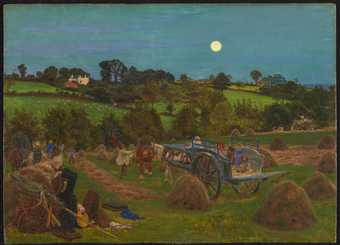
Not on display
- Artist
- Ford Madox Brown 1821–1893
- Medium
- Oil paint on canvas
- Dimensions
- Support: 711 × 991 mm
frame: 995 × 1270 × 80 mm - Collection
- Tate
- Acquisition
- Purchased with assistance from the Art Fund and subscribers 1916
- Reference
- N03065
Summary
This is the first of three paintings by Brown that illustrate scenes from Shakespeare's tragedy King Lear. All three pictures are based on a series of pen and ink sketches produced during a trip to Paris in 1843-4. On 2 May 1848 Brown saw William Charles Macready (1793-1873) in a production of the play, and began work on this picture in November of the same year.
The painting illustrates Act IV, Scene vii from the play. The location is Cordelia's tent in the French camp at Dover. Lear is asleep, his thinning hair straggling across the pillow, his hands still clutching a set of keys. The physician on the left raises his baton and commands the musicians to play more loudly. Cordelia, anxious that her father should be allowed to sleep, utters this lament, inscribed in both spandrels of the frame:
Had you not been their father, these white flakes
Had challeng'd pity of them. Was this a face
To be explosed against the warring winds?
To stand against the deep dread-bolted thunder?Mine enemy's dog,Though he had bit me, should have stood that might
Against my fire; and wast thou fair, poor father,
To hovel thee with swine, and rogues forlorn,
In short and musty straw!
Lear's recumbent pose suggests the exhausted sleep of old age, while Cordelia, kneeling with outstretched hands, is the pitying onlooker. The stage-like setting is organised into a many-angled tent, its shape reinforced by the shallow arch of the frame. The isolation and stillness of the foreground figures are underlined by the half screen and the throng of musicians beyond. They seem constricted in their movements and the bright light of the distant seashore through the tiny opening in the tent only serves to emphasise the darkness and gloom of the claustrophobic interior.
Brown used models for most of the figures, but the head of Lear was inspired by 'a cast of Dante's and a drawing of Coulton' (diary entry, quoted in Parris, p.65). He used his favourite model, Maitland, for the soldiers on the right, and his new pupil and friend, Dante Gabriel Rossetti, for the fool, who holds Lear in his sinister stare. He modelled the head of Cordelia on his own wife-to-be, Emma, but the hands were those of a professional model, Mrs Ashley. In order to render the spirit of Shakespeare's play, he chose to dress his figures in the costume of the 6th century when, according to Brown himself, as noted in his 1865 catalogue, 'paganism was still rife, and deeds were at their darkest.' Behind Lear's head he includes a detail from on of the main scenes in the Bayeux Tapestry.
The picture was first shown at the Free Exhibition in 1849, where it was well received, but remained unsold. Brown continued to work on the picture intermittently until 1854, when it was bought by John Seddon the architect for 15 guineas.
Further reading:
Leslie Parris (ed.), The Pre-Raphaelites, exhibition catalogue, Tate Gallery, London 1984, reprinted 1994, pp.65-66, reproduced p.66, in colour.
Virginia Surtees, The Diary of Ford Madox Brown, New Haven and London, 1981.
Kenneth Bendiner, The Art of Ford Madox Brown, Pennsylvania 1998, p.41, reproduced fig.21.
Frances Fowle
December 2000
Does this text contain inaccurate information or language that you feel we should improve or change? We would like to hear from you.
Display caption
This is one of three paintings by Ford Madox Brown illustrating Shakespeare’s play King Lear. This scene shows Lear with his youngest daughter, Cordelia, on the right. Lear’s doctor orders the musicians to play more loudly and awaken him. But Cordelia is anxious that her ailing father should sleep and she speaks the lament inscribed on the painting’s frame. In the play Lear divides his kingdom between his other two daughters and their husbands. But, after a painful period of self-discovery, he realises that Cordelia is his only true loving child.
Gallery label, July 2007
Does this text contain inaccurate information or language that you feel we should improve or change? We would like to hear from you.
Explore
- architecture(30,960)
-
- residential(5,553)
-
- tent(77)
- music and entertainment(2,331)
-
- music(916)
- characters(438)
- ‘King Lear’(3)
- clothing and personal items(5,879)
-
- helmet(272)
- instrument, harp(35)
- instrument, lute(40)
- instrument, stringed(32)
- bed(401)
- actions: expressive(2,622)
-
- pointing(185)
- arm / arms raised(839)
- kneeling(502)
- reclining(814)
- sleeping(315)
- beard(206)
- UK cities, towns and villages(12,725)
- Kent(1,084)
- England(19,202)
- England, South East(5,940)
- England, Southern(8,982)
- arts and entertainment(7,210)
- doctor(205)
- soldier(1,204)
- king(115)
You might like
-
Ford Madox Brown Jesus Washing Peter’s Feet
1852–6 -
Ford Madox Brown Chaucer at the Court of Edward III
1856–68 -
Ford Madox Brown Our Lady of Good Children
1847–61 -
Ford Madox Brown The Brent at Hendon
1854–5 -
Ford Madox Brown Study for the Dean in the ‘Execution of Mary Queen of Scots’
c.1840 -
Ford Madox Brown Sketch for ‘Jesus Washing Peter’s Feet’
1852 -
Ford Madox Brown Sketch for ‘Cromwell on his Farm’
c.1853 -
Ford Madox Brown ‘Take your Son, Sir’
?1851–92 -
Ford Madox Brown Stages of Cruelty
c.1856 -
Ford Madox Brown Carrying Corn
1854–5 -
Ford Madox Brown Head of a Girl
date not known -
Ford Madox Brown Portrait of Dykes Barry as a Child
1853 -
Ford Madox Brown Jesus Washing Peter’s Feet
1857–8 -
Ford Madox Brown Sketch for ‘Jesus Washing Peter’s Feet’
c.1851 -
Ford Madox Brown The Hayfield
1855–6

